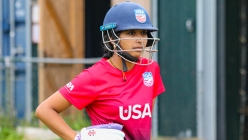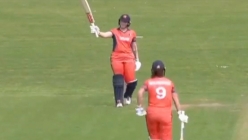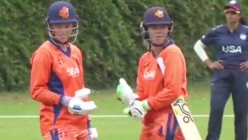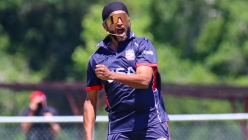USA Cricket News
USA Cricket: 2023 ICC Women’s U19 T20 World Cup Tour Review Part 2 – Player Evaluations
2023 Jan 26 by DreamCricket USA
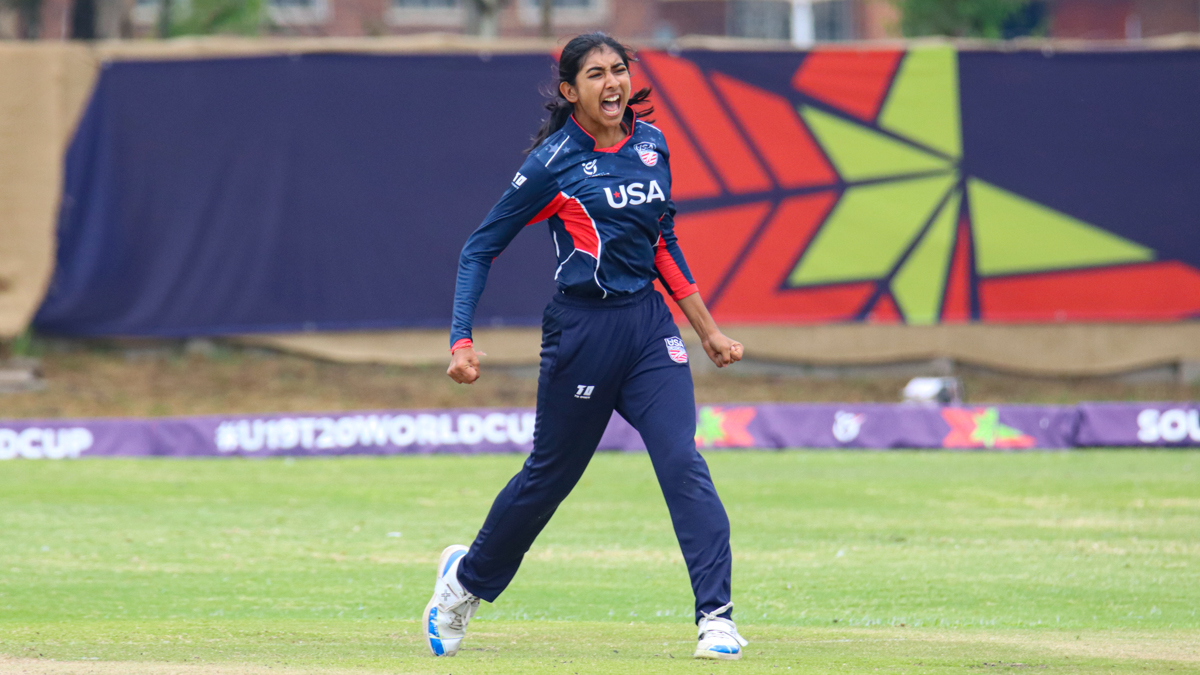
By Peter Della Penna (Twitter @PeterDellaPenna)The second part of the USA Women's U19 World Cup tour review focuses on individual player evaluations for each of the 15 members of the touring squad who took the field of play during the tournament, including the team's joint-leading wicket-taker Aditi Chudasama.
Photo credit: Peter Della Penna
Disha Dhingra – The right-handed opening batter led the team in scoring at the tournament with 74 runs in four innings including a top score of 30 against Scotland and also scored the most boundaries on the team with 12. Dhingra also was a part of both of USA’s only two half-centuries in the tournament, though on both occasions her partner scored the majority of runs in the stand and made them at a quicker rate.
In line with that, Dhingra also had the highest dot ball percentage of anyone in the team, accumulating 74 dots in the 107 balls she faced (69%). It also means she had as many dot balls as run scored. It is a near carbon copy of her performance during the Women’s T20 World Cup Qualifier in September when she had 44 runs and as many dot balls in 66 deliveries faced, though the dot ball percentage was only 67%. The average opener in T20 cricket has a dot ball percentage hovering between 45 and 50%. Meanwhile elite openers have a dot ball percentage of around 40%.
Dhingra is a tremendous timer of the ball with the majority of her boundaries coming between cover and backward point via the cut shot, but needs to improve on her touch and placement – especially against spin bowling – to be able to reduce the number of dot balls and score more singles to better rotate the strike which will ease pressure off both herself and her partner.
She also is one of numerous players who needs to make dramatic improvements in both her ground fielding and catching in the air, though her throwing arm is better than most in the team. But the number one area for improvement above all else is running between the wickets. Dhingra was runout three times in three group matches. She was also runout twice in five matches during the Women’s T20 World Cup Qualifier in the UAE in September, and was involved in other runouts involving her partners. An opener can’t be involved in such a high frequency of runouts.
Though she did not bowl a single over during the tournament due to the nature of conditions favoring slow bowling, Dhingra impressed onlookers when she bowled her fast medium pace in one of USA’s warm-up fixtures. She has consistently impressed over the past year when given an opportunity to bowl and already is arguably USA’s quickest bowler. Still only 16, it is entirely possible that her long-term future success at senior level will be as a fast bowling allrounder, if not a specialist fast bowler because nobody else in the team can match her pace, and that includes Geetika Kodali.
Laasya Mullapudi – The left-handed opener finished second on the team in the tournament with 61 runs in four innings, finished second on the team with 11 boundaries, and also produced USA’s highest individual innings score by making 43 against Scotland. Mullapudi also top-scored with 33 in USA’s warm-up match win over UAE prior to the start of the tournament.
After taking nine balls to get off the mark against Scotland, Mullapudi found a tremendous fluency and rhythm, peppering the boundary by showing skill against both full and short pitched deliveries on a faster-paced wicket inside the Willowmoore Park Oval Stadium compared to the slower paced wicket outside on the nursery oval at Willowmoore Park B. Her overall dot ball percentage was 64% but was only 52% in her innings against Scotland. If she can get the scoring shot percentage and dot ball percentage closer to evening out at 50% on a more regular basis, it will benefit both herself and the team greatly.
The nursery oval exposed some technical deficiencies in Mullapudi’s game, mainly that she pushes at the ball with hard hands – quite often well out in front of her body – and does not* wait for the ball to play it underneath her eyes. It resulted in a pair of dismissals against Australia and Bangladesh from leading edges back to the bowler and to extra cover respectively when she was through her shot too soon. Part of this may be a product of playing too many matches on artificial wickets before needing to transition to natural turf where the ball doesn’t come onto the bat as quickly, a common problem among a significant number of players developed in the USA. The best way to cure the issue is playing more frequently on turf, though that will always be a challenge in the USA.
Like a number of players, the target area requiring the biggest improvement for Mullapudi is in her fielding: along the ground, catching in the air, and developing better arm strength.
Snigdha Paul – The left-handed batter/right-arm medium pace allrounder was USA’s most consistent contributor throughout the tournament. In the first match against Sri Lanka, she produced a brilliant new ball spell returning figures of 1 for 2 in three overs including a maiden. In the Australia match, she top-scored for USA with 17, but was also involved in a number of runouts that resulted in her partners walking back to the dugout.
All the runouts from the Australia match could have easily rattled many players. However, Paul showed a bit of mental toughness by coming back out two days later and played with tremendous freedom, adventurousness and skill to take calculated risks by using her feet to Bangladesh’s spinners and manipulated the field in clever fashion to top score with 26. She also had a quality finishing burst against Scotland when shuffled lower down the order, finishing that innings with a boundary off the last ball.
Paul also showed tremendous improvement with rotating the strike compared to her appearance at the Women’s T20 World Cup Qualifier in September. On that tour, her dot ball percentage was 76%. In South Africa, she lowered it to 59%. There’s still room to get better and get it down closer to 50% for a player batting in the top 3, but Paul showed major strides to correct that between the two tours and it showed in her ability to better manipulate the field as the U19 World Cup tournament went on.
On the whole, Paul was USA’s third highest scorer in the tournament with 54 runs including a best of 26. With the ball, she was also USA’s third best wicket-taker finishing with three wickets in 10 overs at an average of 17.66 and an economy rate of 5.30 (also third best in the tournament). She was also part of the first half-century partnership USA had in the tournament alongside Dhingra against Bangladesh.
Paul’s biggest area for improvement is in the field. She needs to improve her reaction time to the ball coming off the bat, take better angles/routes to cut off the ball, improve her catching and throwing. Paul is generally a sure-handed catching fielder if the ball is hit directly to her, but struggles with chances which require adjustments moving laterally or forward/backward. This is something that can be corrected with more consistent training.
Ritu Singh – The offspinning allrounder finished fourth in scoring for USA with 44 runs in three innings with a best of 22 against Scotland and was one of two USA players who had a strike rate over 100 in the tournament along with Geetika Kodali. Often used in a finishing role, Singh’s dot ball percentage was 39%. An average T20 finisher has a dot ball percentage hovering between 30-35% whereas elite ones get it down to between 20-25%. In that context, she is actually doing a reasonable job. With marginal improvements she can reduce the dot ball percentage to be in the median range.
With the ball, Singh did not fare as well. Often utilized in high pressure situations at the death when teams were looking to attack, she was targeted and wound up with the highest economy rate on the team (for bowlers who bowled a minimum of one over per team match) giving up 8.82 runs per over in 8.3 overs. This was a bit of an anomaly as her economy rate was a full run lower at the Women’s T20 World Cup Qualifier ostensibly against a better standard of batter.
In the field, Singh missed multiple chances and took no catches on tour, which was surprising considering she is one of the better catching fielders on the team. She also has one of the stronger throwing arms from the boundary and is generally one of the top three all-round athletes in the field for USA. She consistently takes good angles/routes to the ball in the field, is one of the best fielders at sliding/diving to save runs and generally collects the ball cleanly along the ground without any bobbles or fumbles.
Singh’s biggest area for development is identifying a more clearly defined role for her both bowling and batting. At times during the past year she has been used as a new ball spinner whereas on this tour she was used more at the death. Similarly with the bat, she has been used as an opener in the past but was used more as a death overs hitter in South Africa. The reason for that is because she is arguably USA’s cleanest ball-striker in spite of a loose technique. If anything, she tends to rein herself in at times by trying to block or straight bat too many deliveries (something she basically did on a free hit she faced against Scotland that dribbled away for a single to the leg side) in an effort to seemingly try to bat long or survive at the crease when instead she may be much better served just going out and trying to smash it with her natural hand-eye skills.
Geetika Kodali – The captain became a major source of debate for the few number of overs she bowled in the tournament. She only bowled two overs across three matches in the group stage on pitches which favored spin bowling, then bowled a full four-over spell against Scotland on a pitch which was more suited to pace bowling.
One way to look at this is that she was unselfish in prioritizing her spin-bowling teammates whose skills were better suited to getting wickets on the pitch surfaces used in the group stage. The other side of the argument is that she should have been more selfish and had more faith in her own bowling, particularly in the match against Sri Lanka when her lone over conceded five runs and produced a chance that was dropped.
When she bowled a full spell in the Scotland match, she returned decent figures but was sorely let down by the fielding. On the whole, she took one wicket in six overs for 47 runs and an economy of 7.83. What does not appear in those stats is that she had four chances put down off her bowling.
With the bat, Kodali has emerged over the course of the last year as the USA Women’s U19 squad’s best finisher. She showcased that in brief cameos during USA’s last two matches against Bangladesh and Scotland, making 16 off 16 and then 13 off 9 balls, which included USA’s only six of the tournament. Her six against Scotland showed off her strength that is unmatched in the team, but her fours during other parts of the event sweeping over square leg showed not just her shot development but her intelligence in recognizing the weak spots in the field where runs could be manipulated. On the whole, she scored 41 runs at a strike rate above 100 and had a dot ball percentage of 40%. That could be improved even more, but the gap is relatively small to reduce to get it within the acceptable median range.
Previously, Kodali had been one of USA’s better catching fielders, but during the tournament she sometimes put herself in lower traffic positions. Whether that was to be able to focus better on the captaincy aspects of being on the field is unknown but she is arguably a better utilized fielder in situations across different teams where she has not been a captain, if such a thing is possible.
Isani Vaghela – The medium pace allrounder went wicketless in 5.3 overs conceding runs at an economy rate of 8.29 per over. Her style of pace highlighted that anything less than express was going to sit up to be whacked on the slower wickets at the Willowmoore Park B nursery ground.
With the bat, Vaghela scored 35 runs in four innings at an average of 11.66 with a best of 17 not out off 17 balls against Bangladesh when she helped Kodali give USA a solid finish in the last five overs. At the Women’s T20 World Cup Qualifier in the UAE in September, Vaghela’s dot ball percentage was 59% but she brought it down to 46% in South Africa. It was a noticeable improvement, but there’s still room to get better. Batters coming in at No. 4/5 in T20 generally have a 35-40% dot ball percentage on average.
In the past, Vaghela has been a standout fielder for USA patrolling the boundary. She was less assured on this tour, making a number of misfields along the boundary. Her throwing arm strength is above average within the team as is her catching (though she took no catches on tour) but she can definitely sharpen up her ground fielding to clean up mistakes which are atypical of someone with her athletic ability.
Anika Kolan – The vice-captain and wicketkeeper completed one dismissal behind the stumps during the tournament and had zero missed chances. It’s hard to penalize a wicketkeeper for not taking more catches when there were few if any edges coming her way.
With the bat, Kolan has slipped into a peculiar funk. She scored a matchwinning 48 not out against Trinidad & Tobago in the de facto final of the CWI Rising Stars Women’s U19 Championship in July, but runs have been few and far between since then. Part of her effectiveness at domestic level which garnered her maiden selection for the USA senior team in 2021 was her confidence using her feet to spinners. But that is no longer seen in her game, which again points to a confidence rather than skill-based issue.
Her running between the wickets is another major area for improvement. At domestic level, she is outstanding at judging when to take a single or two, but struggled to make the adjustment recognizing a higher standard of fielder in the U19 World Cup. Kolan was at fault for the runout of Dhingra in the Sri Lanka match, and then was at fault for her own runout in the Australia game by making a two-fold error of taking way too long to respond to the call from Mullapudi for a run to mid-off followed by jamming her bat down too hard and late into the pitch – which resulted in it being jammed in the ground and falling out of her hand to result in the runout – when she was trying to get across the line at the striker’s end instead of beginning to ground it earlier.
Aditi Chudasama – USA’s joint leading wicket-taker on tour, Chudasama bowled a team-leading 13 overs taking four wickets at a team-best average of 15.00 and a team-best economy rate of 4.61, which was all the more impressive because the majority of her overs were bowled with the new ball.
Traditionally, Chudasama has been a top-order batter – she won several batting awards in domestic tournaments in 2022 including Best Batter at the USA Women’s National Championship in August – but slid down the order and focused on her spin on the U19 World Cup tour for the benefit of the team. As a result, she only faced 15 balls on tour, scoring 7 runs.
Chudasama is positioned as one of USA’s best catching fielders by virtue of being placed in high traffic boundary areas during the slog overs. She is athletic sliding and diving to stop balls along the ground, and she took two catches. However, she missed a key chance late in the Scotland match when her body was in a poor position that resulted in her reaching across her body rather than having her body fully behind the ball to cushion the catch. Similar to Paul, she is sharp when the ball is hit directly to her but is less sharp when lateral movements are necessary to get into position for a catch. It’s a subtle thing to correct and can be done with more practice.
Bhumika Bhadriraju – Along with Chudasama, Bhadriraju was USA’s joint-leading wicket-taker on tour with four wickets at an average of 22.25 and an economy rate of 7.41. Bhadriraju’s offspin style is very different from Chudasama – or anyone else in the USA – giving the ball tons of flight to encourage players to try to smash her out of the ground, resulting in a large number of boundary-catching opportunities and stumpings. The stumpings are where she showcases her exceptional intelligence in reading a batter’s tells and tendencies to know when to anticipate the right time to slant a ball quicker or wider out of reach.
As for her batting, though she may be a tailender, she has shown on this tour and previous ones that she also thinks just as much about her batting to try to use gaps in the field to her advantage. She is arguably the player in the squad who thinks and analyzes opposition players in the heat of battle the most and makes quicker in-game adjustments than most players in the team.
Bhadriraju misses the eligibility cutoff for the 2025 ICC Women’s U19 T20 World Cup by just three days, which is unfortunate because she would be a tremendous asset for her experience and shrewd analytical mind. She has shown on this tour and in the Women’s T20 World Cup Qualifier tour that she is more than capable of holding her own as a bowler at senior women’s level.
Like most players in the team though, Bhadriraju must make drastic improvements to her fielding in all aspects: ground fielding, catching and throwing arm strength.
Sai Eyyunni – One of the youngest and least experienced players in the team having only started playing competitive organized cricket in 2021, Eyyunni has made incredible progress in short time to not only make the Women’s T20 World Cup Qualifier squad in September as well as this U19 World Cup tour, but be a constant bowling threat at both junior and senior level. When she first appeared at the 2021 USA Cricket Women’s and U19 National Championships in Florida, Eyyunni was bowling three or four bad balls an over and one wicket-taking ball an over. She still bowls one wicket-taking ball an over, but she has trimmed that bad ball ratio down to usually one bad ball an over at most as her control has drastically improved to be able to build better pressure and threaten consistently for wickets.
Eyyunni took one wicket for 48 runs in 8.4 overs at an economy rate of 5.53 an over, fourth best on the team. However, her bowling from spell to spell was much better than the wickets column may indicate.
Eyyunni’s catching and throwing arm strength has also improved dramatically in the last year from where it first began, but she still has major strides to make in terms of angles/routes to the ball along the ground and overall catching and arm strength.
Tya Gonsalves – A late arrival on tour as an injury replacement for Taranum Chopra, who left without ever taking the field, Gonsalves wound up playing the last two matches. Arguably USA’s best fielder, she took USA’s most impressive catch of the tournament latching on to a laser off the bat of Scotland’s Ailsa Lister at short midwicket. She also took one more catch in that match.
Conversely, she also missed three other chances in the same game – which began with a (near) collision with Ritu Singh in the first over in the field. Ironically, they were arguably USA’s two best fielders in the XI that day. It shows how far USA’s collective fielding has to improve if two of their best options are making communication errors as well as not converting a majority of their chances. Gonsalves was also involved in a missed runout opportunity where her one bounce relay against Bangladesh was fumbled by the bowler standing over the stumps at the non-striker's end.
With the bat, she only came out in the Scotland match and made a scratchy 7 off 15 balls in which she chewed up 11 dot balls at a crucial stage of the game in the second half of the innings. Players need to hit out or get out at that stage. Getting out for 0 off 3 balls is not nearly as bad a result as chewing up 11 deliveries and not scoring.
With the ball, Gonsalves did not bowl any overs of her offspin, which was slightly unusual considering she was ostensibly brought in as a like for like replacement for Chopra’s offspin and also when weighed up against some of the other spin options that struggled with their economy rate.
Gonsalves’ biggest area for improvement is in her core batting and bowling skills, particularly in being more efficient by using up fewer dot balls. Being down the batting pecking order is arguably why she was left off the touring squad from the beginning, though her fielding was not valued nearly as much as it should have been when it came to squad selection as her catch to dismiss Ailsa Lister, a player who top-scored against USA in the warm-up match between the two sides, arguably could have been a match-winning one had USA not crumbled under pressure down the stretch.
Suhani Thadani – After a breakout tour with the USA Women on her senior team debut in Mexico in 2021, Thadani has not maintained the same rate of progression. She played just one match on tour, bowling a single over for nine runs against Australia. Like others, Thadani needs to work to significantly improve her fielding in all areas.
It also did not help that conditions were not in her favor as a pace bowler, which played a factor in her limited opportunities. But more work needs to be done by local coaches to get Thadani back to her best.
Pooja Shah – The bowling allrounder played the opening match of the tournament against Sri Lanka, but due to the nature of conditions, did not bowl at all. With the bat, she entered at No. 8 and scored 1 off 9 balls at a critical period in the final three overs when USA needed to be scoring at a run a ball as a baseline objective.
In the field, Shah has one of the top throwing arms in the team from the boundary which is evident in her multi-sport background (Shah plays varsity basketball at her high school in Texas). Shah will be eligible for USA in the next U19 World Cup cycle and if she continues to develop her core skill sets, she could prove to develop into a valuable allrounder by the 2025 U19 World Cup.
Pooja Ganesh – The youngest player in the USA squad and one of the youngest players in the tournament, Ganesh served the role of reserve wicketkeeper and opening batter. Team management decided to keep the faith in the same opening pair all tournament in spite of an inability to convert starts into significant scores and a case can be made that the decision was justified by their performance in the final game against Scotland. However, it meant that by the time the first wicket fell in the Scotland match, the batting order had been reshuffled to reflect time/overs remaining in the match and as a result, Ganesh did not face a single ball on tour.
As a matter of principle on a junior tour (and in particular in a consolation match after USA had already been eliminated from the Super Sixers/knockout stage), it would have been ideal for Ganesh to get a chance to bat at least once. Team selection in junior/age group/development tours are rarely always about picking the best XI, especially by the time consolation matches are being staged. It would have been good to see what she could have done with the bat if given an opportunity, just to know where she is at developmentally and what things she needs to work on compared to what she is already excelling at. In particular, she has a reputation for being an exceptionally aggressive batter, more so than the majority of top-order options that had been used on tour, and it wouldn’t have hurt to shake things up just to see a different and more aggressive stylistic approach from a player like her at the top of the order.
As for Ganesh’s wicketkeeping, she had one stumping in the Scotland match and should have had another when an appeal was ruled not out despite TV replays showing the Scotland batter in question clearly having her foot outside the crease at the time the bails were removed. She conceded no byes or missed chances as well. It is hard to criticize her keeping in any way for a tidy performance.
In training sessions, Ganesh demonstrated arguably USA’s strongest throwing arm when being rotated into team fielding drills as a non-keeper, which is extraordinary considering her tiny frame. She has a very solid multi-sport athletic foundation, which is evident in her throwing and catching, and her arm strength will only get better in the next two years as she continues to grow. A case can be made that she offers more value to USA as an outfielder than a wicketkeeper as a result because she already has one of the best throwing arms in the team despite being the youngest player on tour.
Jivana Aras – The second oldest player in the team (one month younger than Gonsalves) and one of the least experienced players in the team having only taken up organized cricket after the Covid pandemic, Aras has developed quickly to reach the U19 World Cup squad. She had been used in key roles on previous tours when conditions suited fast bowling, but like other pace bowlers, her opportunities quickly became limited when it became clear that the group stage wickets were tailored more towards spin and slow bowling.
Having said that, her treatment by team management on the final match day of the tour was poor and a near identical situation to the Crystal Zins saga from the 2022 USA Cricket Women’s Regionals in July wound up unfolding on tour in which Aras did not bat or bowl a single ball. The Zins situation was unique in that she paid her own way to Texas whereas when a player is picked for USA’s U19 World Cup squad, all their expenses are paid to travel overseas on tour to South Africa. As a result, the overarching mentality is to pick the best XI when the tournament is still alive for a chance at progressing to the knockout stages.
However, picking the best XI is not necessarily the objective once a team is thrown back into a consolation match/loser’s bracket. Historically at that stage in ICC Men’s U19 World Cups and other junior/developmental tournaments, team management generally makes every effort possible to ensure everyone gets to play at least one full match if they fall back into a loser’s/consolation bracket, and efforts are also made to ensure the player in question gets to play a significant role in the match by being given opportunities to bat or bowl in key roles.
If USA management was still of the mindset that they wanted to win at all costs in the consolation Scotland match (which became evident when Pooja Ganesh was never given a chance to face a delivery), then at worst the opening over of the chase should have been given to Aras to bowl. If Aras did not succeed, then the over is out of the way and the team can adapt quickly and early in the chase to compensate for an expensive over. If Aras did succeed in that opening over (whether by taking a wicket or bowling economically), the option is there to keep her on for additional new ball overs.
But by delaying the opportunity to give her a chance to bowl at least one over, team management backed themselves into a corner the longer the match went on and the tighter it got to the point where it became clear that they were not willing to take a risk to bowl her in a late-game pressure situation when she hadn’t bowled a competitive over on tour. Instead, team management was determined to keep cycling through the same frontline options utilized in the group stage. A case could also be made that bringing her on to bowl in the 17th, 18th, 19th or 20th overs would also have been wildly unfair to her to put her in such a pressure situation for her first and/or perhaps only over of the tour, which is why giving her the new ball made the most sense. On the flip side, had she been thrown into the deep end in the death overs and succeeded, it may have raised questions about why she had been held back all tour.
Win or lose, Aras deserved to bowl, and the opening over of the chase was the most sensible opportunity to guarantee that it was not delayed or forgotten about in the heat of battle later on in the chase. The fact that USA lost the match without her being used underscored the futility of chasing a win at all costs. If they were going to lose, they may as well have given her a chance to bowl because the result couldn’t have been any worse with Aras being utilized against Scotland, but now we’ll never know if the result would have been better. There were a number of ways that the situation could have been handled better to make sure Aras got to bowl at some stage against Scotland, but none were used.
Getting away from that, even though Aras is currently classed as a specialist bowler, she has loads of unrealized potential with her batting. Her physical traits, in particular her height, gives her the frame and leverage to strike the ball with more power than most players in the squad and she has the capacity to develop more strength to become a genuine power hitter. For the time being she has focused mainly on her bowling but she showed flashes of her unexplored batting potential – both in terms of technique and temperament – in a famous partnership with Isani Vaghela in Florida during the USA Women’s National Championship in 2021.
Aras has been invited to be a part of the next Fairbreak Women’s T20 initiative that begins in Australia later this month. If anything, she can use her snub from the U19 World Cup tour as motivation to prove any doubters wrong when she gets opportunities in that event. And like the majority of her teammates, Aras also needs to work to significantly improve her fielding.
[Views expressed in this article are those of the author, who was present in South Africa for all of the USA Women’s U19 team’s matches on tour, and do not necessarily represent the views of DreamCricket management. If you have different views or opinions, we respect those views and urge you to provide your feedback, both positive and negative. Feel free to respond to the author via Twitter @PeterDellaPenna.]

